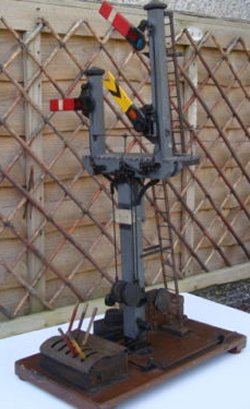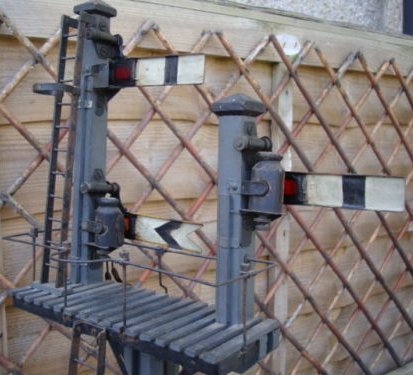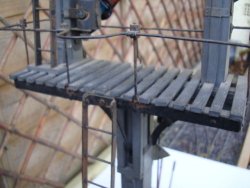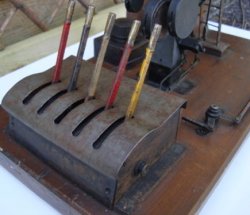
LMS Slotting Signal Demonstrator
It would appear that some time in its formative years the LMS needed to demonstrate to trainee S&T linesmen how slotting of signals worked. To do this they constructed a scale model bracket signal that allowed the principles to be seen in the training room.
We know this because the model was recently sold on eBay and we are very grateful to the seller for permission to reproduce his images here.




The description read: "Here we have for auction a very rare fully working training model of a London Midland and Scottish Railway 2 doll bracket signal. The signal is made from wood and metal and it is believed to have been made in the 1940s and to have come from one off the railway signalling training schools of the LMS to demonstrate the "slotting" arrangement where the distant signal of the box in advance is mounted beneath the starting (section) signal on the same post which is controlled by the box in rear.
In such a situation a fool proof mechanical system is provided to prevent the distant signal from being cleared when the stop signal is at danger, the lever controlling the distant signal in the box in advance actually operates a counter weight at the base of the signal mast. The distant signal blade is connected to a separate counter weight, which is held in the lifted position by a tee piece secured to its operating arm. The distant signal weight and the starting signal weight arm is mounted on the same spindle and are all independent of each other.
When the lever operating the starting signal is pulled this operates the stop signal blade to the off position. Providing the stop arm is "off" when the box in advances distant lever is pulled the counter weight is over balanced and the distant blade comes "off" . If the stop signal lever is returned to its "normal" position both stop and distant blades return to danger and caution respectively: without this system the distant signal was off the driver could end up passing the starting signal at danger !
This model demonstrates the accurately from the miniature lever frame at the front of the model. There are five levers in the frame and from left to right they operate: 1 left hand doll 2 section of point rodding and crank 3 spare lever 4 main right hand stop arm 5 distant signal. At some stage the signal may have had working electric lamps which would have been powered by batteries, this may have been a later addition. One lamp is missing and the others have no wiring to them although this could be installed. Studying the paintwork on the signal blades this has a old crazed and blistered finish and the whole signal has a great patina all over. The height is 24 1/2" tall and the base is 15" x 9". The width of the signal at the widest point is 11". The signal is built to a scale of 3/4" which is correct for 3 1/2" gauge railways. This is a great item, which would grace any railway collection and is very pleasing to operate."
Based on the LNW-style post and angle cranks, and assuming the model was based on current practice, this may have dated from c. 1930.
The item sold for £456.89 on 16 January 2015.


